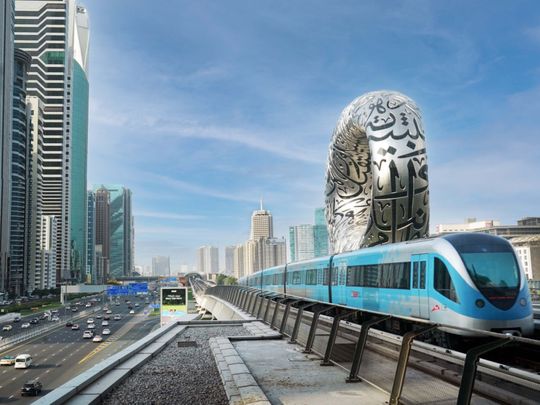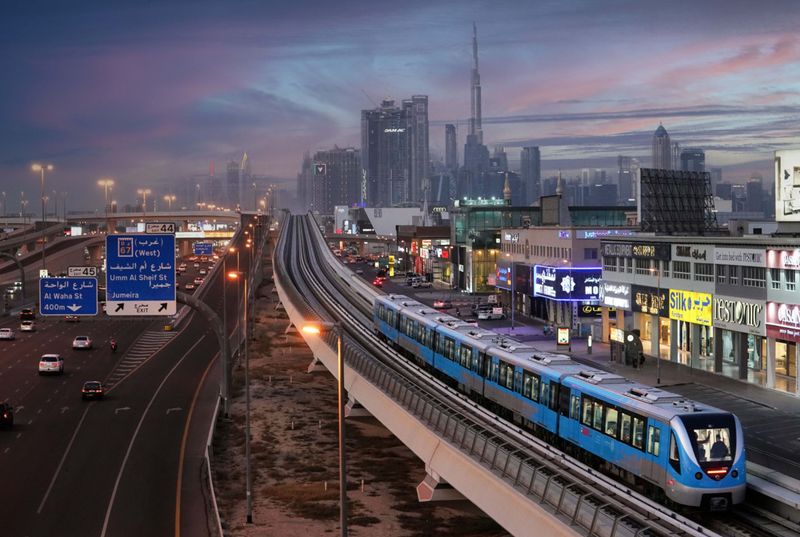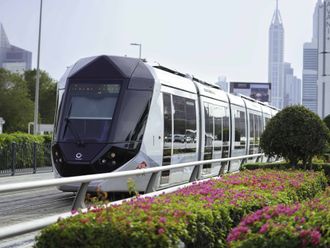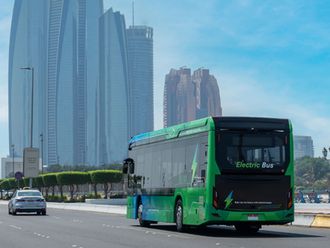
Dubai: There is no doubt Dubai Metro has transformed the way people move across the city.
From the time His Highness Sheikh Mohammed bin Rashid Al Maktoum, Vice-President and Prime Minister of the UAE and Ruler of Dubai, tapped the first Nol card to become its first passenger at exactly the ninth second of the ninth minute at 9pm on September 9, 2009, Dubai Metro has become the backbone of the emirate’s public transport system.
Since then, Dubai Metro — which is recognised as the world’s longest driverless metro network with a length of 89.3 kms — has served over 1.9 billion commuters in the past 13 years.
As we look back, it is good to note not only the number of passengers who use Dubai Metro that is remarkable but also its safety and operational efficiency that has reached a near perfect score of 99.8 per cent in the first half of 2022, up from last year’s record of 99.73 per cent.
Dubai Metro is also the main showpiece of Dubai’s visionary plan to raise the share of driverless public transport to as much as 30 per cent by 2030.

Realisation of a vision
According to Roads and Transport Authority (RTA), Dubai Metro is one of the visionary ideas of Sheikh Mohammed to provide a world-class infrastructure that will make Dubai a global centre for business and finance, with sustainability at its core.
This is the reason why the seven latest stations on Dubai Metro’s Route 2020 were all awarded with LEED (Leadership in Energy and Environmental Design) Gold Certification for their efficient infrastructure and “crucial role in protecting the environment, saving costs and preserving resources.”
Read More
- #DubaiDestinations: Musicians from around the world strike a chord at Dubai Metro Music Festival
- Look: Female Emirati drummer wows crowd at Dubai Metro Music Festival
- Dubai: RTA warns motorists not to park under Metro viaducts
- RTA launches new metro link service, improves timetables of other bus routes
Leadership in service
The Route 2020 stations, which run from Jebel Ali Station on the Red Line to Expo 2020 Station, opened for operations on January 1, 2021 initially with four stations (Jebel Ali, The Gardens, Discovery Gardens, and Al Furjan) and followed by Dubai Investment Park station on June 1, 2021; while the opening of Expo 2020 and Jumeirah Golf Estates stations coincided with the start of Expo 2020 Dubai on October 1, 2021. These stations are leaders in international standards for quality and environment friendliness. RTA noted: “Route 2020 stations are designed with the concept of sustainability woven in all dimensions while embracing top international and national initiatives.
The exterior designs of Route 2020 stations feature four different patterns, highlighted by the iconic Expo Station, which emulates the plane wings depicting Dubai’s take-off to the future and innovation.
The interchange station linking Route 2020 and the Red Line at Jebel Ali Station as well as the elevated stations of Route 2020, have a design akin to the design of the current metro stations to maintain the identity and shape of metro stations along the Sheikh Zayed Road.
The colour schemes of the stations were selected to reflect the UAE’s geographic environment and cultural identity. Blue was chosen for Jebel Ali and Al Furjan stations to replicate the aquatic environment, and green was chosen for The Gardens and Dubai Investments Park to symbolise air and nature. A selection of inspiring colours were chosen for Jumeirah Golf Estates Station, the largest metro station in the Dubai Metro network with an area of 28,700 square meters.

Sophisticated operations
RTA noted its Rail Operations Control Centre is one of the most sophisticated control centres in the world. It manages the daily operations of the metro service on the Red and Green lines 24/7.
“The process requires a high level of accuracy and speed as well as compliance with the highest standards of safety, security, and convenience to riders. The centre assist Dubai Metro to achieve the highest international levels of safety, operational efficiency, service punctuality, faster maintenance operations, decision-making, and lower potential malfunctions,” it added.
RTA further explained: “The centre enables control and monitoring of the rolling stock as well as the performance of the automated communication systems and electrical transformers of trains and metro stations. It also manages the passenger information system, the entry of trains to the track and controls the operation and movement of trains. It also monitors the environmental control as well as the safety, firefighting, ventilation and air-conditioning systems in tunnels, stations and trains. It also ensures the functionality of brakes, doors and engines in each train.”
Metro amenities
The comfort of passengers is of utmost importance. RTA said the public can avail some of the finest and top-end amenities within stations while commuting, including Wi-Fi access and mobile network coverage across the entire metro network.
Safety and security are also vital. Metro trains and stations have surveillance cameras to ensure security around the clock, as well as emergency communication call boxes. Moreover, a wireless network connects the metro with emergency units, and a special police unit is placed to monitor security and safety.
Metro’s future
There are currently 53 stations in both Red and Green Lines. Dubai Metro also maintains a fleet of 125 trains. Back in January 2021, during the inauguration of Route 2020, Abdul Mohsen Ibrahim Younes, CEO of Rail Agency at RTA, told Gulf News there are plans to extend Dubai Metro’s Red Line up to Al Maktoum International Airport, to create a metro link with Dubai International Airport.
The daily ridership of Dubai Metro has returned to the pre-pandemic levels, and even recorded more than 125 million passengers in the first seven months of the current year alone, nearing the total of 113 million and 151 million recorded in 2020 and 2021 respectively.
“The rise in passenger numbers is a testament confirming the importance of Dubai Metro, which translates the insightful future vision of the mass transportation system,” the RTA said in a statement sent to Gulf News on Thursday, on the eve of Dubai Metro’s 13th anniversary.
It added Dubai Metro will continue to serve the community by providing the finest service. “It will also maintain its leading position in areas of safety, adopting effective environmentally friendly solutions and strengthening the foundations of the green economy as well, while achieving operational efficiency and punctuality.”
1.9 billion passengers have been served since inauguration on September 9, 2009 until July 2022
53 stations, including 7 stations on Route 2020 awarded LEED Gold Certification
125 trains Dubai Metro
99.80% — almost perfect record adherence to operational efficiency in the first half of 2022
2010 — 39,089,000 (almost 600% jump)
2011 — 69,001,000
2012 — 109,049,000
2013 — 137,076,000
2014 — 164,031,000
2015 — 178,065,000
2016 — 191,033,000
2017 — 200,075,000
2018 — 204,041,000
2019 — 202,098,000
2020 — 113,063,000
2021 — 151,026,000
2022 — 125,089,000 (until July)








